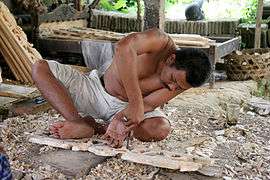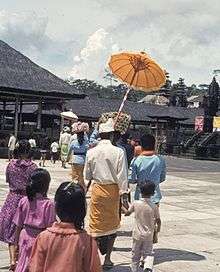Balinese people
|
A Balinese couple during their wedding and their friends. | |
| Total population | |
|---|---|
| (4.2 million (2012 census)) | |
| Regions with significant populations | |
| 3,946,416[1] | |
| Bali | 3,336,065 |
| West Nusa Tenggara | 119,407 |
| Central Sulawesi | 115,812 |
| Lampung | 104,810 |
| Southeast Sulawesi | 49,411 |
| South Sumatera | 38,552 |
| South Sulawesi | 27,330 |
| 5,700[2] | |
| 5,529 | |
| 200 | |
| Languages | |
| Balinese language, Sasak language, Indonesian language | |
| Religion | |
| Balinese Hinduism | |
| Related ethnic groups | |
| Javanese, Sasak, Tenggerese, Sundanese and Austronesian peoples | |
The Balinese (Indonesian: Suku Bali) are an ethnic group native to the Indonesian island of Bali. Balinese population of 4.2 million (1.7% of Indonesia's population) live mostly on the island of Bali, making up 89% of the island's population.[3] There are also significant populations on the island of Lombok, and in the eastern-most regions of Java (e.g. the Municipality of Banyuwangi).
Origins

The origins of the Balinese came from three periods. The first waves of immigrants came from Java and Kalimantan in the prehistoric times of the proto-Malay stock.[4] Followed by the second wave of Balinese came slowly over the years from Java during the Hindu period. The third and final period came from Java, occurred in between the 15th and 16th centuries, which was about the same time during the conversion of Islam in Java, causing aristocrats and peasants to flee to Bali after the collapse of the Javanese Majapahit Empire in order to escape the Mataram's Islamic conversion. However, this in turn reshaped the Balinese culture into a syncretic form of classical Javanese culture mixed with many Balinese elements.[5]
A DNA study in 2005 by Karafet et al., found that 12% of Balinese Y-chromosomes are of likely Indian origin, while 84% are of likely Austronesian origin, and 2% of likely Melanesian origin.[6]
Culture

Balinese culture is perhaps most known for its dance, drama and sculpture. The island is also known for its form of Wayang kulit or Shadow play theatre. Even in poor rural and neglected villages, beautiful temples are common-sight; and so are skillful gamelan players and talented actors.[7] Even pieces of palm leaf layers and neat fruits arrangement made for offerings by Balinese women have an artistic side to it.[8] According to José Miguel Covarrubias, works of art made by amateur Balinese artists are regarded as a form of offering, and therefore these artists would not care for recognition of their works.[9] Balinese artists are also very skillful in duplicating art works such as carvings that resembles Chinese deities or decorating vehicles based on what is seen in foreign magazines.[10]
The culture is noted for its vital use of the gamelan in music and in various traditional events of the Balinese society. Every type of music is purposed for specific event. For example, music for piodalan (birthday celebration) is different from music used for metatah (teeth grinding) ceremony, just as it is for weddings, Ngaben (cremation of the dead ceremony), Melasti (purification ritual) and so forth.[11] The diverse types of gamelan is also adjusted accordingly to the types of dance in Bali. According to Walter Spies, the art of dancing is an integral part of Balinese life as well as an endless critical element in a series of ceremonies or for personal interests.[12]
There are several unique aspects related to the tradition of their religion. Balinese culture is a mix of Balinese Hindu-Buddhist religion and Balinese customs.
Traditionally, displaying of female breasts is not regarded as immodest. Balinese women can often be seen with their bare chest; however, a display of the thigh is considered immodest. In modern Bali these customs are normally not strictly observed, but visitors visiting Balinese temples are advised to cover their legs.
In the Balinese naming system, a person's rank of birth or caste is reflected in the name.[13]
-

Legong dance.
-

Balinese wood carver.
-

Balinese painting.
Puputan
A puputan is an act of mass suicide through frontal assaults in battle, and was first noted by the Dutch during the colonization of Bali. The latest act of puputan was during the Indonesian war of Independence, with Lt. Colonel I Gusti Ngurah Rai as the leader in the battle of Margarana. The airport in Bali is named after him in commemoration.[14]
Religion

The vast majority of the Balinese believe in Agama Tirta, "holy-water religion". It is a Shivaite sect of Hinduism. Traveling Indian priests are said to have introduced the people to the sacred literature of Hinduism and Buddhism centuries ago. The people accepted it and combined it with their own pre-Hindu mythologies.[15] The Balinese from before the third wave of immigration, known as the Bali Aga, are mostly not followers of Agama Tirta, but retain their own animist traditions.
Festivals

Kuta Carnival, Sanur Village Festival, Bali Kite Festival[16]
See also
- Balinese architecture
- Balinese caste system
- Bali Kingdom
- Balinese Kshatriya
- Galungan
- Nyepi
- Saraswati
- Ngaben
- Legong
- Sanghyang
- Kecak
- Canang sari
References
- ↑ Akhsan Na'im, Hendry Syaputra (2011). Kewarganegaraan, Suku Bangsa, Agama dan Bahasa Sehari-hari Penduduk Indonesia Hasil Sensus Penduduk 2010. Badan Pusat Statistik. ISBN 978-979-064-417-5.
- ↑ "Balinese in Malaysia". Joshua Project. Retrieved 2016-04-25.
- ↑ Bali faces population boom, now home to 4.2 million residents
- ↑ Shiv Shanker Tiwary & P.S. Choudhary (2009). Encyclopaedia Of Southeast Asia And Its Tribes (Set Of 3 Vols.). Anmol Publications Pvt. Ltd. ISBN 81-261-3837-8.
- ↑ Andy Barski, Albert Beaucort and Bruce Carpenter (2007). Bali and Lombok. Dorling Kindersley. ISBN 978-0-7566-2878-9.
- ↑ Karafet, Tatiana M.; Lansing, J S.; Redd, Alan J.; and Reznikova, Svetlana (2005) "Balinese Y-Chromosome Perspective on the Peopling of Indonesia: Genetic Contributions from Pre-Neolithic Hunter- Gatherers, Austronesian Farmers, and Indian Traders," Human Biology: Vol. 77: Iss. 1, Article 8. Available at: http://digitalcommons.wayne.edu/humbiol/vol77/iss1/8
- ↑ Adrian Vickers (2012). Bali Tempo Doeloe. Komunitas Bambu. p. 293. ISBN 602-9402-07-2.
- ↑ Adrian Vickers (2012). Bali Tempo Doeloe. Komunitas Bambu. p. 294. ISBN 602-9402-07-2.
- ↑ Adrian Vickers (2012). Bali Tempo Doeloe. Komunitas Bambu. p. 296. ISBN 602-9402-07-2.
- ↑ Adrian Vickers (2012). Bali Tempo Doeloe. Komunitas Bambu. p. 298. ISBN 602-9402-07-2.
- ↑ Beryl De Zoete, Arthur Waley & Walter Spies (1938). Dance and Drama in Bali. Faber and Faber. p. 298. OCLC 459249128.
- ↑ Beryl De Zoete, Arthur Waley & Walter Spies (1938). Dance and Drama in Bali. Faber and Faber. pp. 6–10. OCLC 459249128.
- ↑ Leo Howe (2001). Hinduism & Hierarchy In Bali. James Currey. p. 46. ISBN 1-930618-09-3.
- ↑ Helen Creese, I Nyoman Darma Putra & Henk Schulte Nordholt (2006). Seabad Puputan Badung: Perspektif Belanda Dan Bali. KITLV-Jakarta. ISBN 979-3790-12-1.
- ↑ J. Stephen Lansing (1983). The Three Worlds of Bali. Praeger. ISBN 978-0-03-063816-9.
- ↑ Tempo: Indonesia's Weekly News Magazine, Volume 7, Issues 9-16. Arsa Raya Perdana. 2006. p. 66.

.jpg)